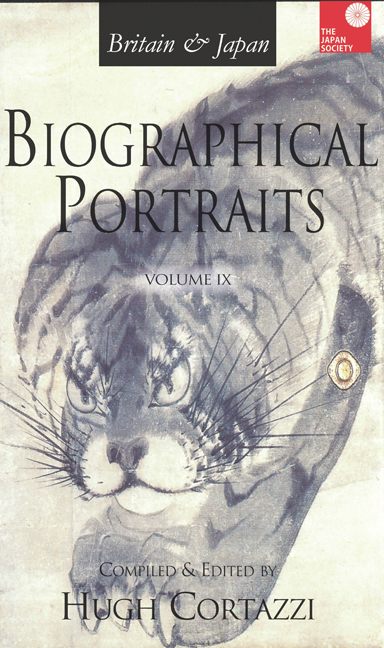Book contents
- Frontmatter
- Contents
- Introduction
- List of Contributors
- Index of Biographical Portraits in Japan Society Volumes
- PART I JAPAN IN BRITAIN: THINGS JAPANESE
- PART II BRITAIN IN JAPAN: TRADE
- BRITISH ACTIVITIES
- MISSIONARIES
- MUSIC, DRAMA AND FILM
- EPISODE
- PAINTERS
- JOURNALISTS
- JAPANESE WOMEN PIONEERS
- PART III SCHOLARS AND WRITERS: JAPANESE
- BRITISH
- PART IV POLITICIANS AND OFFICIALS: JAPANESE
- BRITISH OFFICERS
- BRITISH JUDGES AND A DIPLOMAT
- BRITISH POLITICAL FIGURES
- Index
36 - Yanada Senji (1906–1972): Teacher of Japanese at SOAS
Published online by Cambridge University Press: 30 April 2022
- Frontmatter
- Contents
- Introduction
- List of Contributors
- Index of Biographical Portraits in Japan Society Volumes
- PART I JAPAN IN BRITAIN: THINGS JAPANESE
- PART II BRITAIN IN JAPAN: TRADE
- BRITISH ACTIVITIES
- MISSIONARIES
- MUSIC, DRAMA AND FILM
- EPISODE
- PAINTERS
- JOURNALISTS
- JAPANESE WOMEN PIONEERS
- PART III SCHOLARS AND WRITERS: JAPANESE
- BRITISH
- PART IV POLITICIANS AND OFFICIALS: JAPANESE
- BRITISH OFFICERS
- BRITISH JUDGES AND A DIPLOMAT
- BRITISH POLITICAL FIGURES
- Index
Summary
SOAS STUDENTS in the late 1960s remember Yanada Senji as a mild-mannered man, always impeccably dressed in the style of a 1930s upper-class Englishman. His English was heavily accented but he smiled frequently. He taught grammar from the book Teach Yourself Japanese, which he had co-authored with Charles Dunn, in addition to essays and letter writing (required for the final exams) obviously relishing the formal set phrases. He himself was formal in the best possible way, where formality is really courtesy in visible form. He was a conscientious teacher, bordering on the pedantic, and some of his students had no inkling of his turbulent life and the identity crisis, which plagued him after the war. Others had heard that he had been a newspaper reporter who had stayed on in Britain when war began, who had been interned along with other enemy residents on the Isle of Man but subsequently recruited to aid the war effort, teaching Japanese at SOAS to young linguists who would serve as interrogators and translators in the field and later in occupied Japan.
A TAISHO INTELLECTUAL ABROAD
Yanada Senji was born in July 1906 in the Ushigome area of Tokyo, north east of Shinjuku, a lively residential area, home to many literary and cultural figures. His father, Kyūjirō , was originally from Hiroshima, but had found employment in the lower house of the Diet (taking shorthand) to finance his studies at Senshū University. In 1899 he joined the newspaper Chūgai Shōgyō Shinpō (forerunner to the Nihon Keizai Shimbun) and in 1926 rose to the rank of president.
His eldest son Senji graduated in economics from Tokyo Imperial University in 1931 and like his father went into the newspaper business. In July 1932 he travelled to Los Angeles to cover the Olympics for his father's paper and from there went on to London where he became London correspondent to Hōchi Shimbun. By 1936 he was a member of The Japan Society. In October 1938 he was recruited onto the London staff of the Yomiuri Shimbun.
- Type
- Chapter
- Information
- Britain & Japan Biographical Portraits Vol IX , pp. 413 - 424Publisher: Amsterdam University PressPrint publication year: 2015



